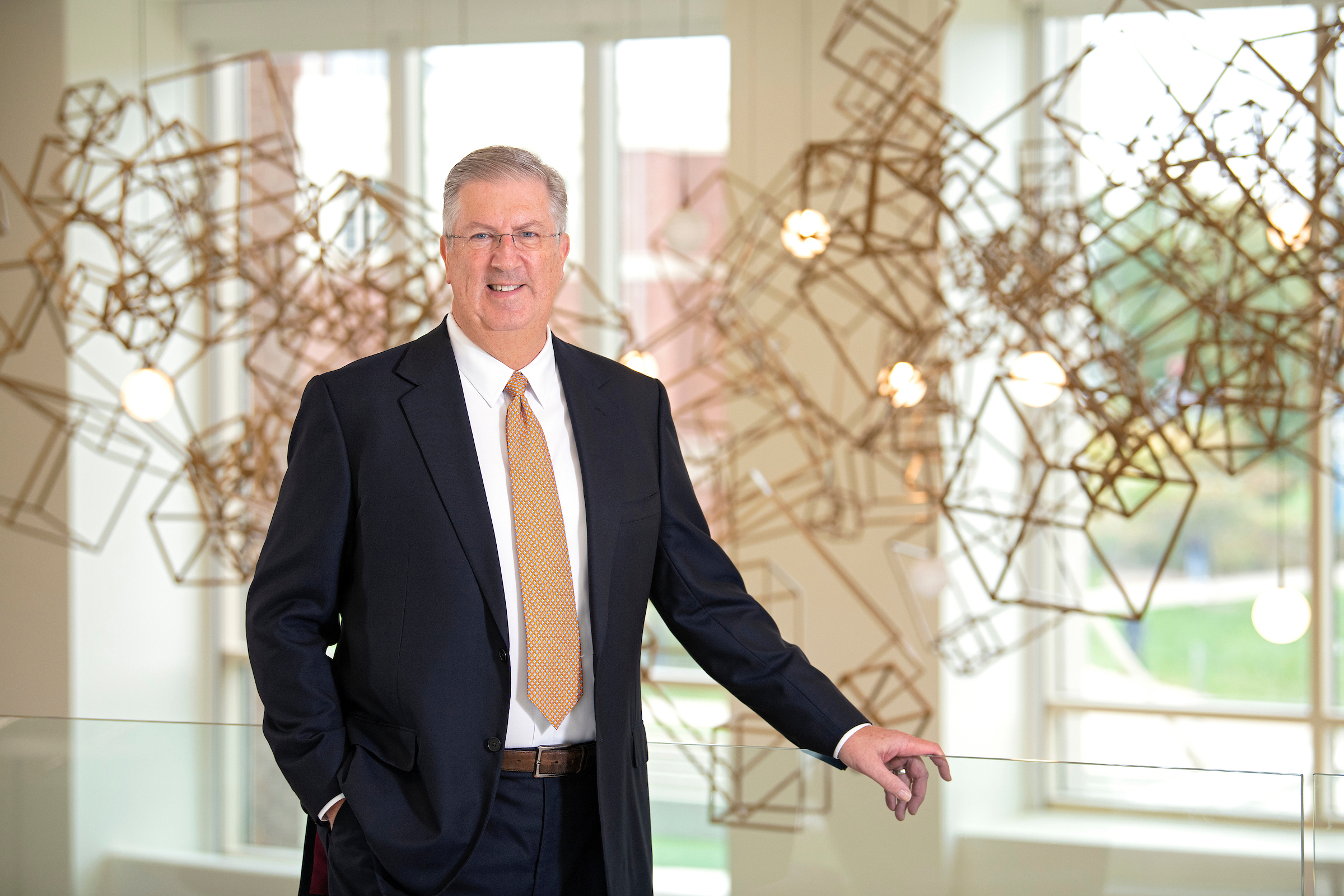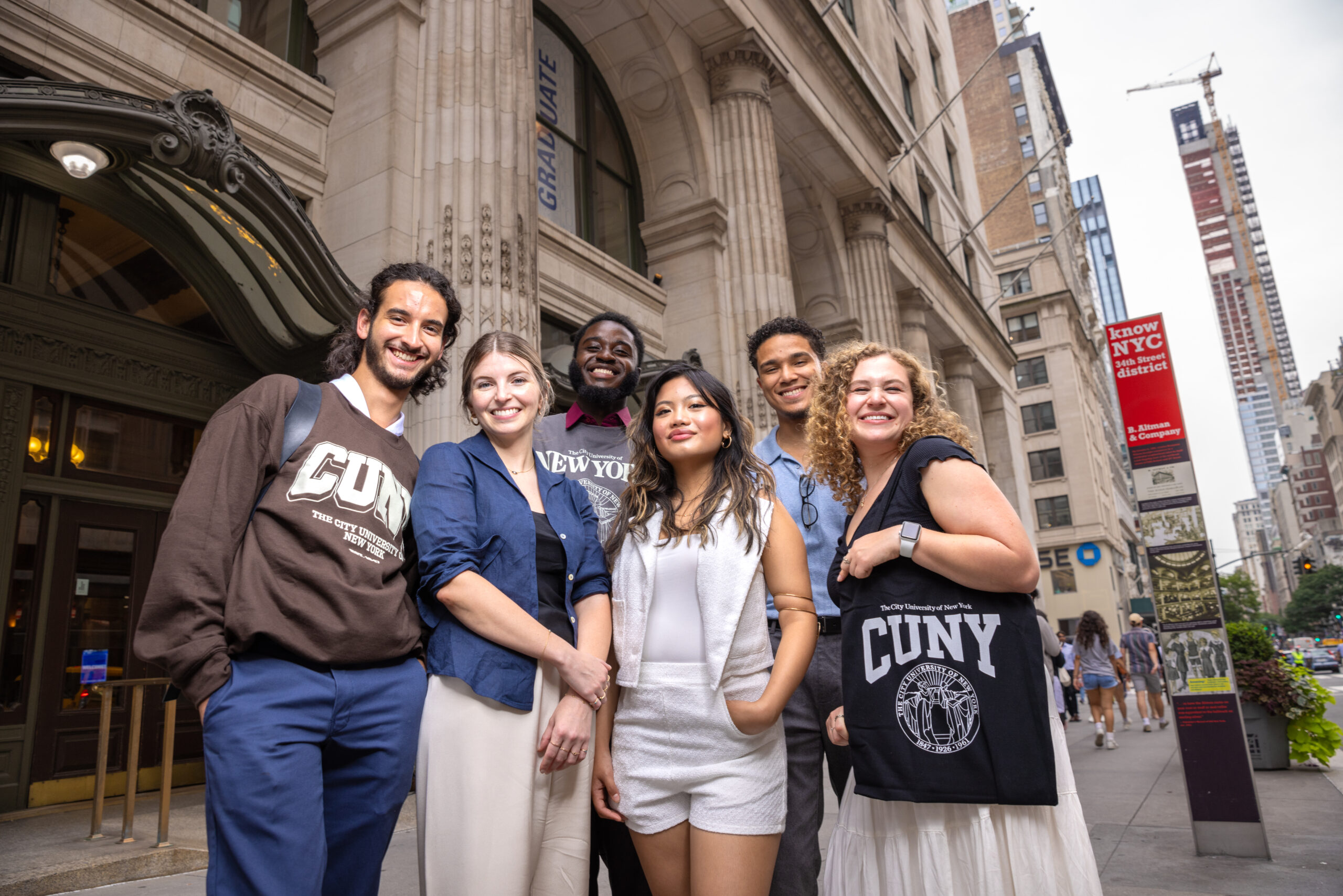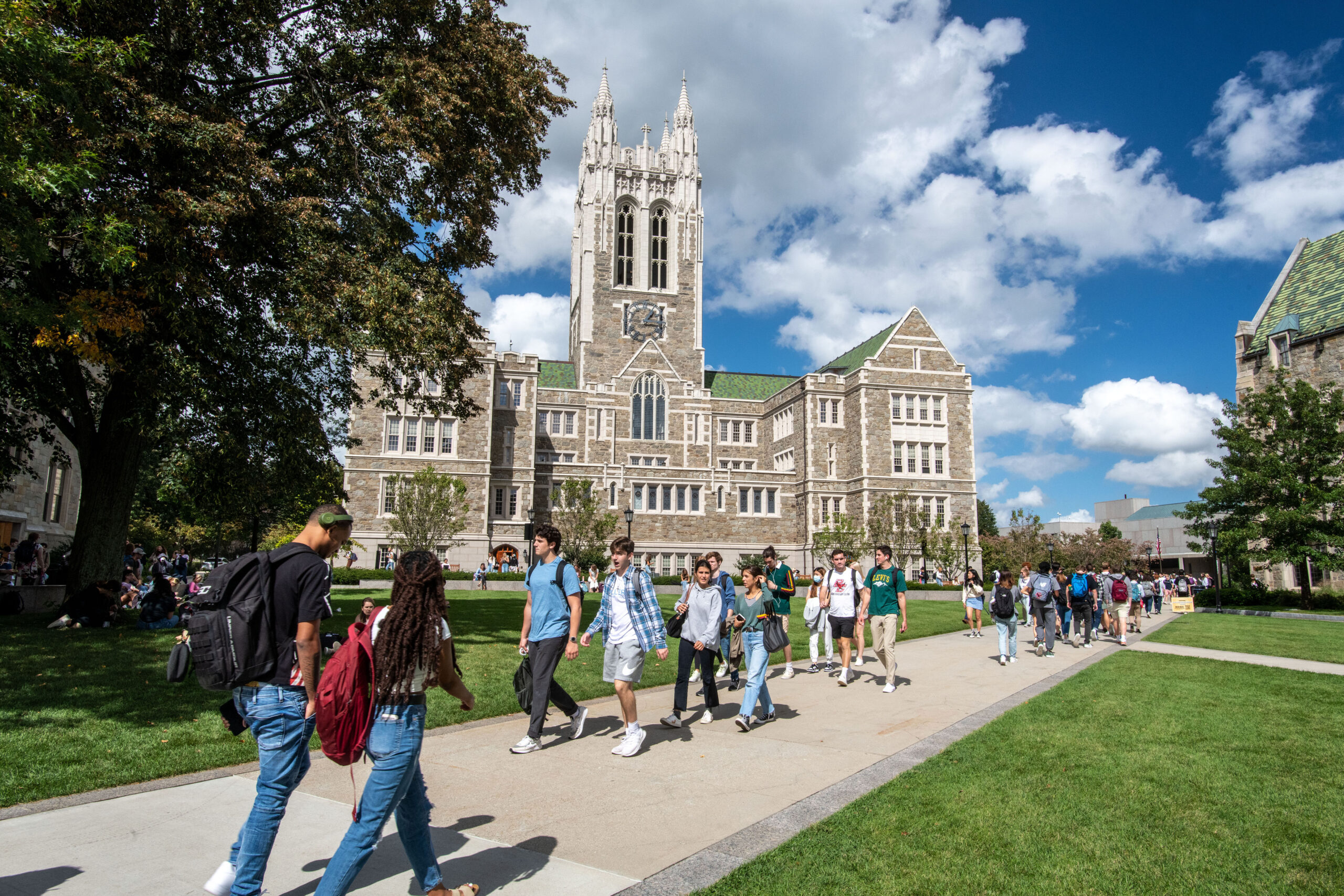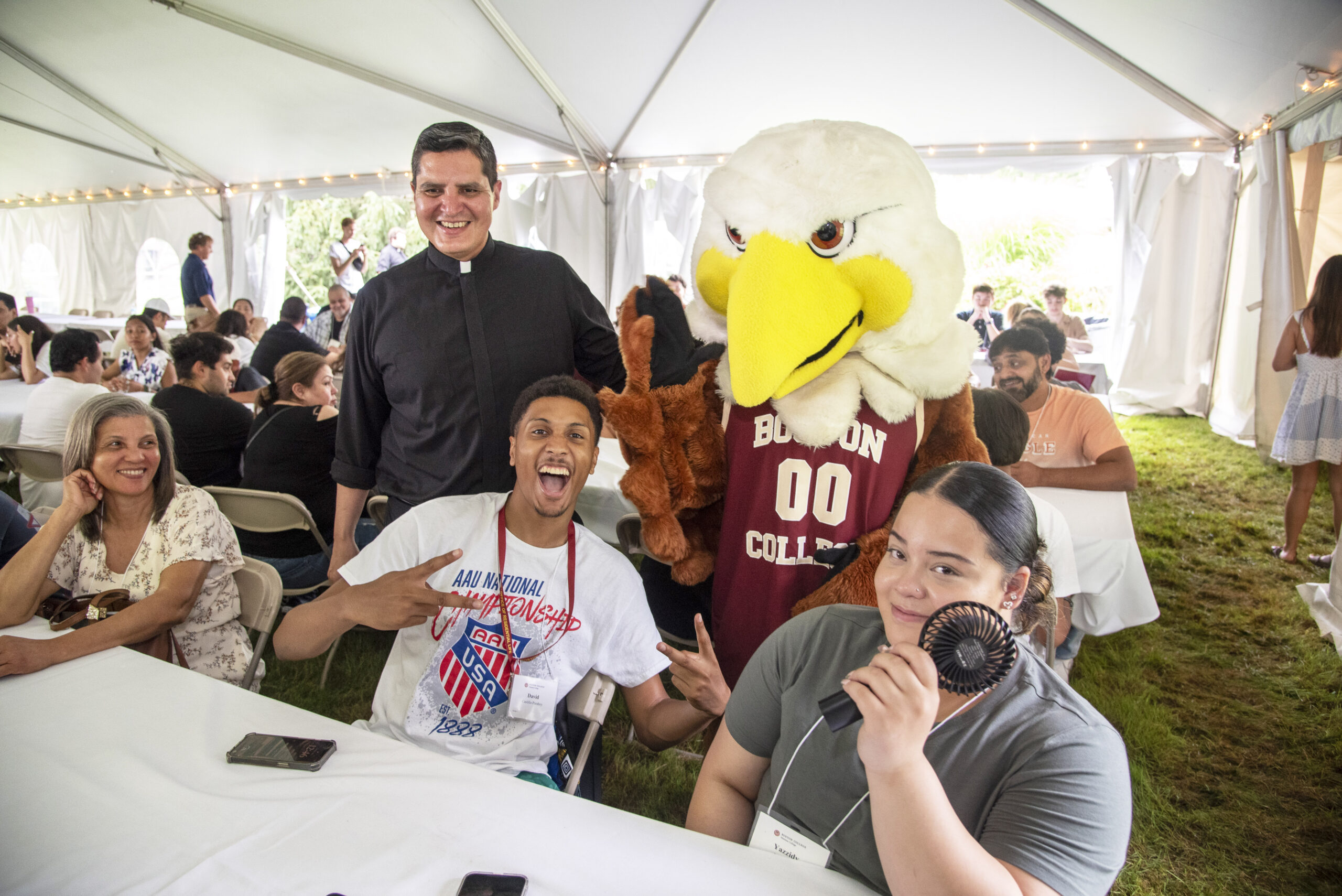At noon three days a week, a room overlooking the pond at the University of Virginia falls into quiet meditation while the rest of campus churns with mid-day activity. Some students sit, some lay on the floor. A facilitator leads with guided thoughts and modes of breathing, but you’re welcome to do your own thing. After about 20 minutes, everyone is back on their way to lunch and afternoon classes.
“It’s very accessible to all kinds of people. It’s a nice break in the day, and it’s powerful for the people who have discovered it so far,” says Dearing Fife, a sophomore who organizes the sessions at the Contemplative Commons.
Dearing is a student advisor at the Commons, a new soaring glass and fieldstone building that is home to the Contemplative Sciences Center (CSC). For more than 12 years, the CSC had been operating from UVA’s religion department with multidisciplinary research, experiential learning, and mindfulness initiatives. The construction of the Commons represents more than an impressive new building to house a department and some activities. It is headquarters for the interdisciplinary face of wellbeing on campus—from grounding activities like yoga and meditation to scholarship on the many intersections of contemplation and nature, art, and technology.
The construction of the new Commons makes tangible President Ryan’s desire for UVA to be a top school for holistic student life while pushing boundaries on what higher education can look like in terms of mental health promotion. For many years, UVA had been the administrative backbone of the Flourishing Academic Network (FAN), an inter-institutional collaboration aimed at promoting student flourishing through higher education.
A Contemplative Commons
On the western edge of campus, the new 57,000-square-foot building sits beside the serene 11-acre pond and watershed area known as The Dell. Its U-shape wraps around a Ginkgo tree-lined courtyard, and connects to central campus via a pedestrian bridge over Emmet Street inspired by the High Line in New York, with benches and plantings. It’s hard to imagine a location better suited for a center dedicated to research, teaching, and outreach for contemplative experience.
“Our building is designed around the three themes of nature, art, and technology, and all three combine together to create contemplative opportunities for individuals,” says Kelly Crace, Executive Director of the Contemplative Sciences Center. “It’s intentionally multidisciplinary, creating wonderful spaces where students just love to come and study, whether they want to come into our art galleries, or come into our Conservatorium and experience light and sound in a variety of ways, or connect with nature through our biophilic design.”
The Commons houses, and reflects, work being done at UVA’s Contemplative Sciences Center. The facility’s purpose is to support student flourishing through a host of indoor-outdoor spaces, academic classrooms, immersive learning and events. It will soon include art installations and flexible studios that can be configured as classrooms, research labs, or even yoga studios.
Technology plays an interesting role in both design and practice in the Commons, used both to enhance mindfulness experiences and to create intentional tech-free spaces for deeper reflection. The Conservatory is an immersive room with floor to ceiling windows, sounds and light panels, with state-of-the-art audio to mimic natural soundscapes—think ocean waves, rainforests, waterfalls, wind, and buzzing bees. Other areas at the Commons are tech-free zones, encouraging students to disconnect altogether.
Innovative Classrooms, both labs and studios, are designed as multi-modal spaces that allow instructors to change the room setup based on the session’s needs. Classes can alternate between traditional seating, or more free-form setup using yoga mats or meditation cushions. Some rooms feature sprung floors, ideal for movement-based practices like Tai Chi, or facilities conducive to a Japanese tea ceremony. Others serve as academic classes that faculty members would prefer to hold in something other than a traditional classroom building.
“There’s one class that meets in the Commons, for example, on medical Spanish. This professor has her own deep contemplative practice, and she incorporates it into every class that she leads,” says Connie Kresge, chief of staff of the CSC. “She’s not just bringing in somebody who’s pre-med to learn a few vocabulary words. She is saying, ‘Okay, you are going to be the front line of working with humans. How do you imbue your practice with understanding of this population and a contemplative, compassionate approach?’ And so they also get the benefit of a setting like the Commons.”
Research and Practice
In a world increasingly defined by speed, competition, and information overload, the CSC represents a shift in higher education. Housed within UVA’s Provost’s Office, CSC benefits from strong institutional support, ensuring its programs are not peripheral but central to the university’s academic mission. As Michael Sheehy, CSC’s Director of Research, points out, UVA’s investment in contemplative education is unique among public universities, positioning it as a leader..
With its three-pronged mission, CSC is reshaping how students, faculty, and the broader academic community engage with education, wellbeing, and leadership. Work and programming at the Contemplative Sciences Center is organized around three pillars: Research, focus on advancing contemplative studies through scholarship; University Life, integrating mindfulness into students’ days; and Systems Change, expanding contemplative education globally through leadership and K-12 initiatives.
At the heart of CSC’s work is a research lab known as CIRCL, which stands for Contemplative Innovation, Research, and Collaboration Lab. There, scholars study many aspects of the ways meditation, nature, and technology shape our well-being from a collaborative, cross-disciplinary perspective.
One of the current projects examines how different environments impact contemplative experiences, explains Sheehy. As part of the methodology, participants will be studied meditating in five different settings, and researchers then track brain activity, heart rate, and emotional responses. “If you meditate in a garden, does it feel different than if you meditate in a featureless white room?” he asks. “What happens in your brain and body when you practice mindfulness in nature?” Sheehy is also editor of the Journal of Contemplative Studies and also Contemplative Currents, which are uniquely poised to cover both peer-reviewed academic studies and open public scholarship.
Research, academics, and collaborations go well beyond the study of nature and meditation. CSC is diving into diverse studies such as virtual reality experiences, lucid dreaming research, and exploration of leadership and public policy.
“We’re having professors coming in from our Batten School of Leadership and Public Policy to talk about policy and leadership from a contemplative perspective, professors from religion to come talk about Buddhism, and we’re exploring collaborative work of how we can do things with the school of data science,” says Crace. “What’s really cool is getting a sense of the breadth and diversity that’s possible. People might initially think, Oh, so this is where you do yoga, or this is where you do mindfulness, that type of thing. Yes, and we’re so much more than that. Being able to bring in that diversity of collaboration, I think, is really important.”
University life
But the CSC isn’t just about research—it’s about making curiosity and mindfulness part of daily student routines to support an overall culture of thriving. The CSC hosts monthly salons, where students and faculty can discuss contemplative topics with leading interdisciplinary scholars. A Citizen Leaders Fellowship offers students a year-long leadership opportunity to gain skills needed to flourish during their time at UVA and after graduation.
Beyond the lab and classroom, the CSC and Commons are uniquely poised to support student flourishing with a wide range of campus programming—beginning with a celebratory weekend of concerts, food and activities in April to mark the grand opening of the Commons. Going forward, a weekly calendar of programming and well-being initiatives include regular yoga, meditation, Tai Chi, reflective writing, and spaces to cultivate mindfulness and resilience.
It’s a bold push against what Crace calls the “stress-glorification culture” of modern academia.
People ask, Why would a university have a building for contemplation? They don’t ask, Why do you have a building for the arts, and a building for sports?
“’I stayed up two nights. Well, I stayed up three.’ It’s this constant one upping, where we’re trying to find distinction through how hard I’m working,” he says. “It’s not only how hard I’m working, but it’s important for you to know how hard I’m working, and it just creates a very toxic culture that really disrupts flourishing. We want to be a disruption to that stress culture.”
Systems Change
Flourishing is a key word in the overall picture of contemplative sciences and its place in a larger ecosystem of institutions helping young adults maturing in a way that best supports their wellness and full potential. Appropriately enough, the Flourishing Academic Network (FAN) grew out of key individuals at UVA committed to flourishing, including David Germano, a religious historian at the University of Virginia and Crace’s predecessor as former director of CSC, and alumni Jeffrey Walker, a finance executive, philanthropist, and member of the board.
“What we’re trying to do with FAN is taking a system orientation and looking at how we can prepare students for the real world, and allow them to succeed in higher ed,” says Walker. “It means giving them tools when they arrive, and educating them about what kind of tools there are out there, working on things like social emotional learning models, meditation, yoga, body movement, breath practices, peer to peer support, and also managing ego and collaborative models, and looking at leadership models.”
For real systemic change, the third pillar of the CSC reaches beyond the campus into the wider scope of academia with FAN, and reaching K-12 classrooms and international leadership programs.
“The systems change work can be thought of as expanding what we do reaching outward,” says Kresge. One major initiative is the Compassionate Schools Project, a groundbreaking K-12 mindfulness curriculum leading new practices in Louisville, Kentucky. Another is the Dalai Lama Fellows Program, which trains young leaders around the world in mindfulness-based social change. In 2024, CSC took 17 Fellows to meet His Holiness the Dalai Lama.
CSC is also working on a national initiative to integrate contemplative education into higher education policy. By partnering with education policymakers and university administrators, CSC hopes to make contemplative practices a core part of the American educational experience—and something both more easily understood and more widely undertaken.
“People ask, Why would a university have a building for contemplation? They don’t ask, Why do you have a building for the arts, and a building for sports? No one stops and says, what do you mean by arts?” says Kresge.. “We don’t have that barrier in our colloquial understand of the words arts and sports, but we do in our conversation of what contemplation is.”
Leaders like Kresge hope there would be a greater understanding of mindfulness and meditation as an ongoing tool and practice—like exercise—and not a one-time thing that can be taught in a seminar and crossed off a list.
Sheehy learned meditation from his grandmother when he was about 10 years old, and it made a lasting impression. “I’ve had the chance to live most of my life with access to knowledge about contemplative practices, because I’ve had experiential access to as a constant reference point,” he says. “That’s why I think the research we do is important, because we’re showing people how these practices wok, how powerful and empowering they can be, and give them agency over transforming their lives.”
Dearing Fife also had access to these practices at an early age, and the addition of the Contemplative Commons at UVA cements her belief she could not have found a better place for herself to attend school. A self-described “anxious kid,” she discovered meditation in middle school, and it’s been a core part of her life ever since. “Like brushing my teeth,” she says. “A non-negotiable.” She grew up knowing that learning to handle it was just going to be her thing.
“Everyone manages something in their life, and I have to manage my anxiety,” she says. She meditates once or twice a day, and believes it’s a tool many more college students would benefit from. She is aware of a first-year student who shows up to the noon meditations regularly, and likes to envision that it’s making a difference in her life—and that in a small way, as organizer of the sessions, Dearing contributes to that.
“It’s a big school, and I’m in Greek life, and that’s been great,” she says. “But I also wanted an academic realm where it’s like, This is my place, and this is where I’m going to impact the university,” she says. “And this, working at the Commons and CSC, is it.”




